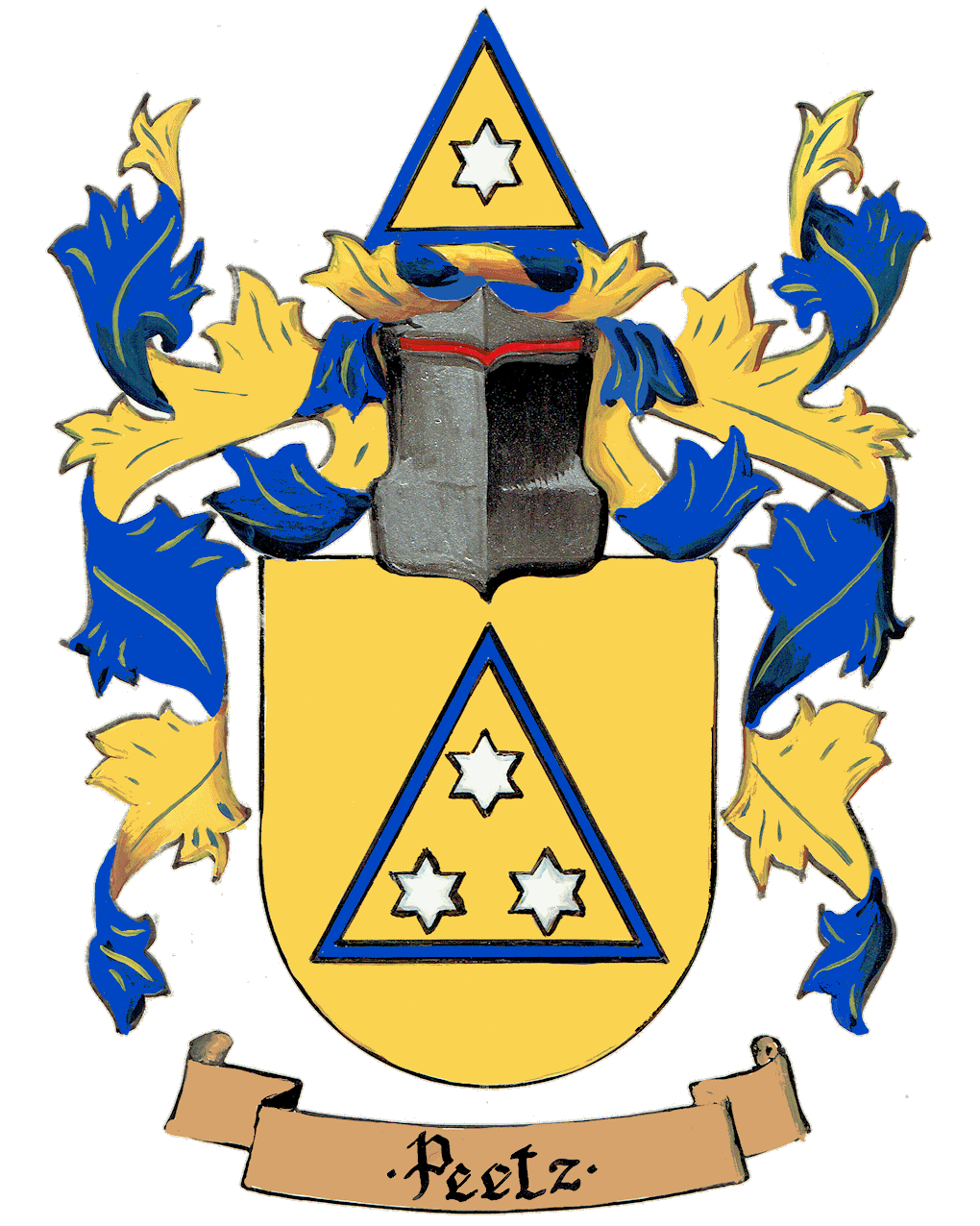

 The Peetz Arms can be found in Rietstap’s Armorial Gèneral (P1.XXV) which reads:
The Peetz Arms can be found in Rietstap’s Armorial Gèneral (P1.XXV) which reads:
‘Peetz— Esthonie. D’or un triangle vidd’ d’azur, et trois étoiles mal— ordonndes d’argent., posses dans le triangle. Cimier— le triangle renfermant une dtoile d’argent et some’ d’une toile pareille. Lambrequins— d’or et d’azur.’ (translation: Estonia.) Of now, to an emptied triangle of blue, and three poorly ordered stars of money, put in the triangle. Crest— the triangle containing a dtoile of money and some' of a similar canvas. Mantling of gold and of blue.
Gold (yellow in heraldry) is thought by some to have represented the first gift given to Christ at his birth and that silver (white in heraldry) was a sign of purity. The true symbolic meaning of the triangle has most probably been lost in the mists of time but it was obviously very important to the bearer. A mullet represented a spur rowel and the bearer was demonstrating that he was a good horseman. Three may have been placed on the shield to represent the Holy Trinity. The original arms are old and probably date from the 12th or 13th century.
|• More...

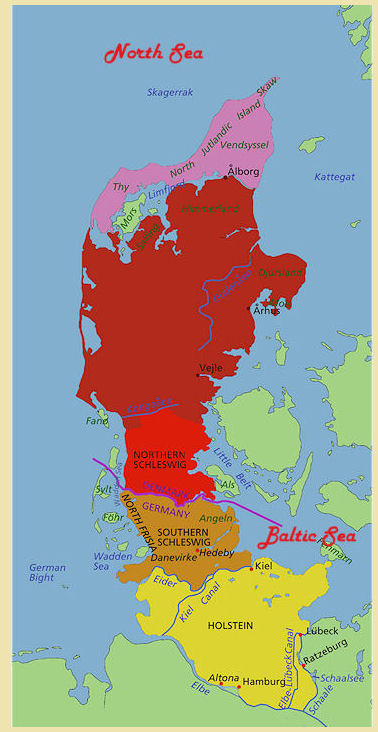 Spanning the region between the Jutland and Eiderstedt Peninsulas, Kreis Schleswig-Flensburg has been inhabited by farmers, fishermen, and boatmen for centuries. The local residents never seemed to have much of a political view, or tried to establish a state of their own. Early attempts made when tendencies of nationalism and independence prevailed, failed, due to the lack of enthusiasm of the local residents. They paid their taxes and minded their own business. They depended on the North and Baltic Seas for what they needed, had, and did.
Spanning the region between the Jutland and Eiderstedt Peninsulas, Kreis Schleswig-Flensburg has been inhabited by farmers, fishermen, and boatmen for centuries. The local residents never seemed to have much of a political view, or tried to establish a state of their own. Early attempts made when tendencies of nationalism and independence prevailed, failed, due to the lack of enthusiasm of the local residents. They paid their taxes and minded their own business. They depended on the North and Baltic Seas for what they needed, had, and did.
The North Sea was also a way of escape in hard times; families left their home aboard ships and made their way elsewhere. Residents further inland were a bit more rooted in the soil growing vegetables and raising cattle.
In 1863, when Prussian and Austrian troops marched into Holstein to secure German interests by driving the Danish army out of the area, a three year period of conscription in the military was introduced. Many choose to emigrate and left without a permit. They were subsequently listed as having failed to show up for military service.
Time, Temperment, Royalty, War and Diplomacy have formed and reformed the political make-up of the Jutland Peninsula lying between the North Sea and the Baltic Sea since the Dark Ages of the fifth century. Monarchy upheaval, periods of plague, famine, religious migrations, labor immigration/emigration, urbanization, wars and wartime destruction brought constant trumoil to the lives of the area's inhabitants through the end of the Great War.
Schleswig was a low-lying region of the Jutland Peninsula with excellent natural harbors along the Baltic coast; the area has a lot of good farmland with marshes and shrublands near the center. Grain, potato, vegetable farming and cattle raising flourish.
From the 5th to the 19th century, Schleswig was under the influence or control of the Saxons, Franks, Danish, Anglo Saxons, Salvic, Prussian and the Holy Roman Empire at one time or other.
Schleswig-Holstein Question
||•The Schleswig-Holstein Question in the early 19th-century began a century long controversy between Prussia and Austria over the status of Schleswig and Holstein. While the population of Schleswig was mostly Danish in the north; the south was mostly German and mixed in the middle. The population of neighboring Holstein was almost entirely German. Denmark allied with the French during the Napoleonic Wars which led to a German feeling of national unity, especially for the strongly bonded areas of Schleswig and Holstein which proposed that the two regions be united to form a single German state. In 1838 some in Denmark began insisting that all of Schleswig be kept within Denmark and the border between Denmark and Germany be established along the Eider River. This further strengthened the German's desire to unite Schleswig and Holstein as one German state and in 1848 open uprising began.
The uprising was helped when the Prussian Army intervened and drove Denmark's troops from Schleswig. The First War of Schleswig lasted from 1848 to 1851 and ended when the Great Powers pressured Prussia into accepting the London Protocol of 1852. Under the terms of this peace agreement, the German Confederation returned Schleswig to Denmark and the Danish government agreed not to tie Schleswig more closely to Denmark than to its sister region of Holstein. But in 1863 the new Danish king was persuaded by the Northern Schleswig Liberals to sign a new Denmark - Schleswig constitution which ignited the Second Schleswig War of 1864. Prussia and Austria again intervened to uphold the 1852 protocol. During the war, Danish military resistance was crushed by Prussia and Austria in two brief campaigns. When the Vienna Treaty was signed in October 1864, Denmark ceded Schleswig and Holstein to Austria and Prussia. Then in 1866, after Prussia beat Austria in the Seven Week War, Schleswig and Holstein became part of Prussia.
After the German Empire was formed in 1871, the Schleswig-Holstein Question became a contest between Germany and Denmark over North Schleswig. A provision of the Treaty of Prague 1866, which ended the Seven Weeks War, stipulated that North Schleswig would be reunited with Denmark if the majority of that area voted to do so, but in 1878 Prussia and Austria cancelled this provision. Following Germany's defeat in The Great War, elections were held in 1920 in Northern and Southern Schleswig so that the local population could decide between between Denmark and Germany. North Schleswig voted 70 percent in favor to join Denmark, while South Schleswig voted 80 percent in favor of remaining within Germany. The result was the creation of Schleswig-Holstein; and the Danish-German boundary that was established in Schleswig has lasted ever since and is no longer a matter of contention.
| ||•For More Information... | |
| ||•Deutschland | ||•Schleswig-Holstein History |
| ||•Schleswig-Holstein | ||•The Schleswig Question |
| ||•Schleswig-Holstein Portal | ||•Schleswig-Flensburg |
| ||•City of Kropp | ||•What is a German Kreis |
| ||•Prussia | ||•German Unification |

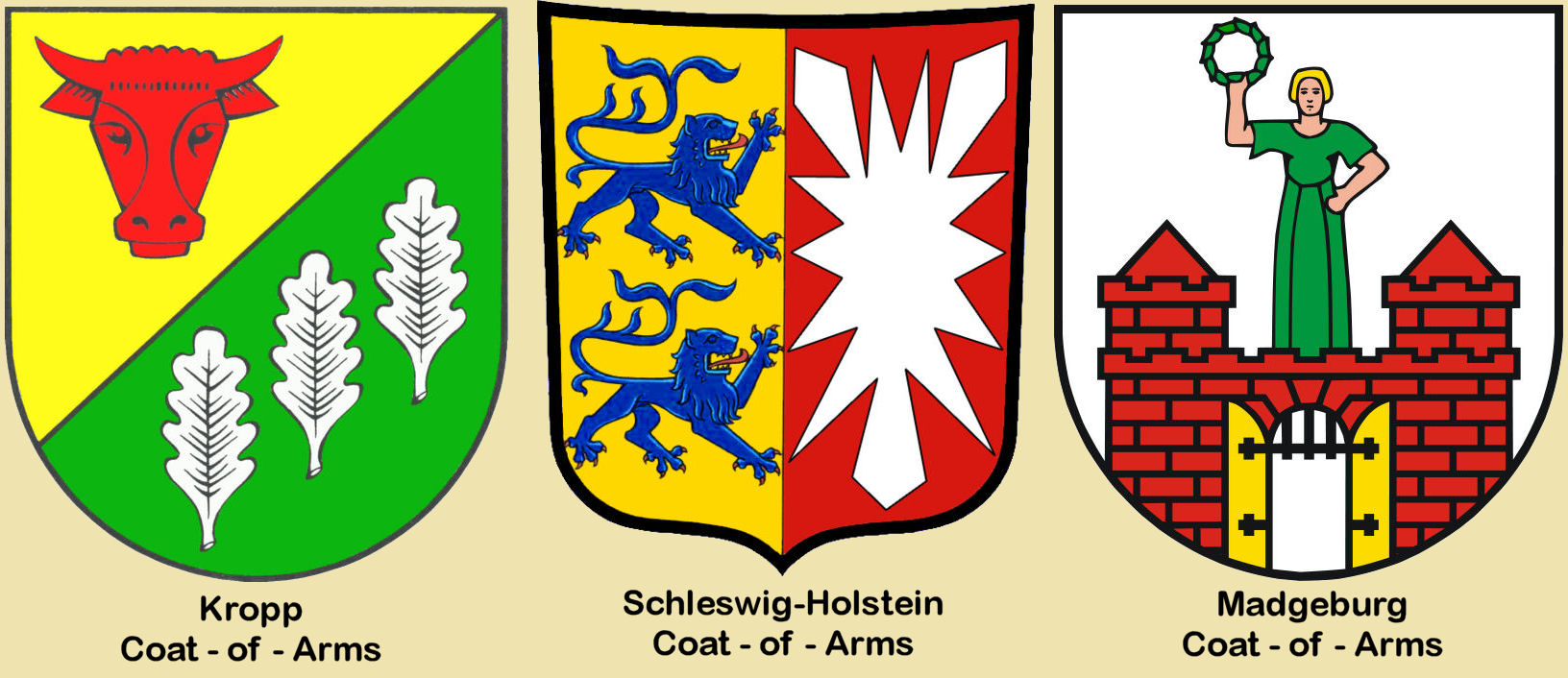
Carl & Hans Peetz
The sons of Otto & Lena Peetz
Kreis Flensburg-Schleswig, Prussia, Deutschland
Otto Peetz (my Great-Great Grandfather) was born in 1810 in Schleswig, Prussia, Deutschland, and died in 1869 in Magdeburg, Sachsen, Prussia, Deutschland. He married Magdalena Lock (born 1810) around 1830; they had five children before Magdalena died in 1863.
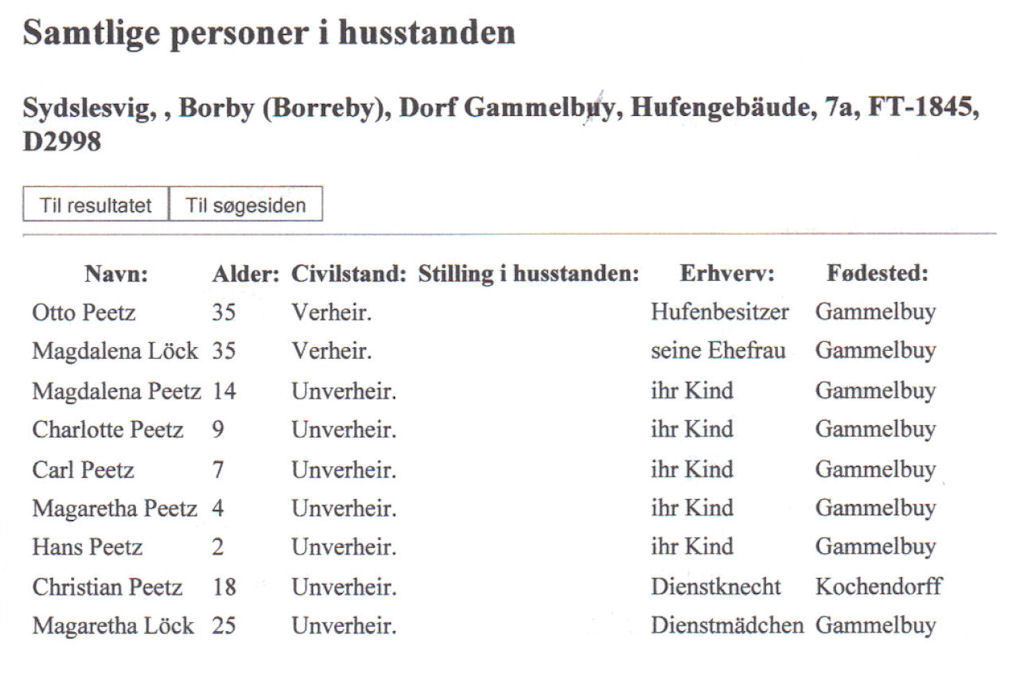
1845 Schleswig Census
Children of Otto Peetz in Germany are:
Magdalena 'Christin' Peetz, born 1831 in Schleswig, Germany; married a Mr. Vollguardsen; died in Magdeburg, Sachsen-Anhalt, Prussia.
Charlotte Peetz, born 1836 in Schleswig, Germany; married Jurgen Guthardt; died in Magdeburg, Sachsen-Anhalt, Prussia (before Dec. 1920; per letters).
Carl S. Peetz, born November 1838 in Schleswig, Germany; died July 1918 in Moro, Sherman County, Oregon.
Margaretha Peetz, born 1841 in Schleswig, Germany married Carl Rath; died in Magdeburg, Sachsen-Anhalt, Prussia (before Dec. 1920; per letters).
Hans Peter Peetz (my Great Grandfather), born August 1843 in Gammelby, Borby Kreis, Schleswig-Flensburg, Prussia, Deutschland; died March 1909 in Posen, Bremen Township, Cook County, Illinois.

Was born November 1838 in Schleswig, Germany, and died July 1918 in Moro, Sherman County, Oregon. He married Catharina 'Katrina' Schott in 1863 in Schleswig, Germany. She was born April 1846 in Schleswig, Germany, and died April 1926 in Moro, Sherman County, Oregon.
In 1861 Carl enlisted in the Army and served for over three years until he was wounded during the War with Denmark. He returned home and farmed locally until he immigrated to America in 1863. Working his way overland he travelled across the United States working on farms in the search of farmland where they could settle. In May 1864, Catharina left Germany to join Carl in Ohio aboard the Barque Eduard (Manifest), the Baltic American Line, from Bremen to New York. In 1873, Carl and ‘Katrina’ homesteaded land in Alexandria, Douglas County, Minnesota where they had their first child, Otto.
Alexandria, Minnesota was founded before the Civil War when two young brothers, Alexander and William Kinkead settled the land in the Minnesota Territory. They traveled along the Red River Train when Minnesota moved from Territory to statehood in 1858. William was commissioned to survey and establish a government road from St. Cloud to Fort Abercrombie in the west. They established a cabin and a U.S. Post office. It took many different forms of transportation to arrive at Alexandria; train, steamship, stage coach and finally prairie schooner. In 1859, the state road was cut through the timber by U.S. Government troops, creating a crude but direct passage from the river port of St. Cloud to Fort Abercrombie (now Highway 27). After the road was completed, the J. C. Burbank Stage line made Alexandria one of its stops. It began a steady migration of settlers around the Alexandria town site.
By the time the Civil War started in 1861, the town had grown steadily. The absence of a railroad and telegraph communication distanced the settlers from the conflict in the South. Some of the local men enlisted in the Army. In August of 1862, the stage brought word that settlers in Minnesota had been killed by an Indian raid and the Indians had declared war on the whites. The new settlers fled by foot, horseback or ox- cart to the more populous communities of Sauk Centre and St. Cloud. They left behind their homes and belongings. The U.S. Army erected a stockade near the sight of Alexandria and it became the center of commercial and social activity until the troops left in the spring of 1866. Most settlers did not return to Alexandria.
 Homestead Certificate No. 307, application 4696 reads:
Homestead Certificate No. 307, application 4696 reads:“Whereas, there has been deposited in the General Land Office of the United States, a certificate of the Register of the Land Office at Alexandria, Minnesota, whereby it appears that pursuant to the Act of Congress approved 20th May, 1862, 'To secured Homesteads to actual Settlers on the public domain,' and the acts supplemental thereto, the claim of Carl Peetz, has been established and duly consummated in conformity to law for Section 3, 130—N, 38-W, NWSW; Section 4, 130-N, 38W, E1/2NE; Section 4, 130-N, 38W, NESE; total 164.46 acres, according to the official Plat of the Survey of the said Land of the General Land Office by the Surveyor General.”
“Now know ye, that there is therefore granted by the UNITED STATES unto the said Carl Peetz, the tract of Land above described, To Have and to Hold, the said tract of Land, with the appurtenances thereof unto Carl Peetz and to his heirs and assigns forever. In testimony whereof, Ulysses S. Grant, President of the United States of America, have caused these letters to be made Patent, and the Seal of the General Land Office to be hereunto affixed.”
“Signed "Given under my hand, at the city of Washington, in the year of our Lord, 1873, By the President, Ulysses S. Grant.”
The Rocky Mountain Locust plagues during the late 1800’s forced Carl and Catharina to sell their land in Minnesota in 1874, Carl and his family moved to Walla Walla, King County, Washington, where they prospered farming wheat. Carl eventually farmed 3200 acres of large kernel wheat that was primarily sold to China for biscuit flour. His farm prospered; he had a reaper-planter machine driven by 26 horses and the railroad constructed a switch at his property. But they were again forced off of their land due to flooding of the Snoqualmie River. In 1886, the family moved to Sherman County Oregon, a short distance across the Washington - Oregon state line.
Carl & Catharina had six additional children; Lena, Lewis, Frederick, Benjamin, Emma and Anna. In July 1893, Carl went to Magdeburg, Germany to visit his sisters. He made another trip to Germany from June 1905 – July 1905. Sometime in 1905, Carl was visited by his brother Hans from Illinois. Carl died in July 1918 and Catharina died in April 1926 in Moro, Sherman County, Oregon.
Children of Carl Peetz and Catharina Schott
Otto Peetz: born March 1873 in Alexandria, Douglas County, Minnesota; died September 1924 in Multnomah County, Oregon.
'Assessor of Sherman County, Oregon, and proprietor of a billiard hall and cigar store, in Kent, was born in Douglas County, Minnesota, March 1873, the son of Carl and Catherine 'Schott' Peetz. At present the father is a retired farmer residing near Moro.'
"When Otto was about one year of age, his parents moved from Minnesota to King County, Washington. This was in 1874, and there they remained until 1886, when the family came to Sherman County. In 1892, Otto went to Grant County, Oregon, where he found employment on several farms, and also conducted a sheep ranch for others, and, at one time, for himself. When he was about fifteen years of age, he was severely injured by a horse which fell upon him, the principal injury being confined to one of his legs. In 1898, he suffered an attack of measles, which seriously affected this limb, and three years later it became necessary to amputate it in order to save his life. Under the care of physicians he remained for a period of eleven months, three months of which time were passed in St. Vincent's Hospital, Portland. A number of operations were made in endeavors to save the injured limb, and following amputation of the same it was twice opened for the purpose of removing dead and decaying bone which might have seriously affected his health, and perhaps caused his death. During the month of December, 1899, he returned to Sherman County and remained with his parents of the farm about one year.
On his recovery in March, 1903, he came to Kent, erected a building, and engaged in his present business. He conducts a billiard table and has a fine stock of cigars, tobaccos and temperance beverages. During the summer of the same year of his arrival he secured land under the homestead laws, nine miles southeast of Kent. June 6, 1904, Mr. Peetz was elected assessor of Sherman County on the Republican ticket, receiving a majority of one hundred and eighty-two. Previous to this he had always been patriotically active in party work but had never aspired to office; in fact his nomination came as a complete surprise to him; it was made in the convention by acclamation.
Great credit is due Mr. Peetz for the heroic manner in which he has borne his sufferings, and for the energy and sagacity displayed by him in overcoming so many business difficulties, as he has. He possesses the confidence of all his fellow citizens, and, as has been shown in the details of this sketch, is a very popular young man in the community in which he resides." - "An Illustrated History of Central Oregon"
Lena Peetz: born 1875 in Walla Walla, King County, Washington Territory; died May 1916.
Lewis L. Peetz: born January 1876 in Walla Walla, King County, Washington Territory; died November 1948 in Wasco County, Oregon. He married Ora Barnum; born c 1880 in Moro, Wasco County, Oregon; died April 1959 in Multnomah County, Oregon.
Lewis was the county commissioner of Sherman County. He maintained a home with his wife Ora. M. Barnum Peetz in Moro - "History of Columbia River Valley" Eventually when Carl’s rheumatism became incapacitating, he sold the farm and turned over its operation to Lewis.
Ora M. Barnum: at that time Wasco, the 'largest county in the world,' as it was called, comprised in its area what is now Sherman County. Her father, Henry Barnum, was a native of New York State and in his youth yielded to the lure of the west, sailing around Cape Horn. He came to the region when eastern Oregon was one great cattle range, unfenced for hundreds of miles. He filed on a homestead in Wasco County, becoming the owner of the land on which the town of Moro was afterward built. There he spent the remainder of his life, raising cattle and horses on a farm in eastern Oregon. Mr. Barnum was a broad-minded man of generous impulses and in his will provided for the maintenance of a school. For each of his children who were a pupil at this school, the district was to receive a bonus of seventy-five dollars per annum, provided he or she attended during three months of the school year. Mr. Barnum attained the full measure of success and in 1884 death terminated his useful and upright career. His widow, Mrs. Elmira (Masicker) Barnum, was born in Yamhill County, Oregon, and passed away in 1923. They were the parents of four children; E.E., a resident of The Dulles and one of the largest wheat growers of this part of the state; Ladru, a grain buyer at the Wasco Warehouse & Milling Company of Moro, or chief field man, vice president and general manager of the First National Bank, vice president of the Bank of Moro, and a director of the Bank of Wasco and of the Eastern Oregon Banking Company of Shaniko; A.H., a breeder of registered Hereford cattle and one of the leading stockmen of Sherman County; and Mrs. Ora M. Peetz, who husband is county commissioner and maintains his home in Moro." -'History of the Columbia River Valley'
Hans Frederick Peetz: born May 1879 in Walla Walla, King County, Washington Territory; died 1946 in Moro, Sherman County, Oregon. He married Margaret ?; born 1888; died 1943 in Moro, Sherman County, Oregon.
Benjamin F. Peetz: born August 1871 in Walla Walla, County, Washington Territory; died April 1957 in Multnomah County, Oregon. He married Ethel May Norcross; born October 1886; died February 1933 in Umatilla County, Oregon.
Benjamin was a deputy sheriff of Sherman County, and one of the most popular young citizens, resides at Moro. He is a Washingtonian' by birth, the place of his nativity being on his father's ranch, on the Snoqualmie river, Novelty, King County, eighteen miles east of Seattle. His father, Carl Peetz, mentioned elsewhere, was a native of Germany; his mother, Christina (Schact) Peetz, the same. At present she resides in Sherman County.
Benjamin is a brother of Otto Peetz, assessor of Sherman County, a sketch of whom appears in another column of this work. Benjamin F. Peetz came to the county with his family when he was about four years of age. He received a good business education in the public schools of Erskine Ville, and subsequently took a profitable course in the Portland Business College. He then engaged in the general mercantile business with R. W. Montgomery, who is mentioned elsewhere at Kent. Two years later they disposed of the business to Balfour, Guthrie & Company, and returned to Moro, where our subject entered the employment of the Moro Implement Company which position he retained until he received the appointment of deputy sheriff, in July. 1904. He is a Republican, although not an active politician. Fraternally, he is a member of Lodge No. 131, I. O. O. F., of Grass Valley; and Cascade Lodge No. 303, B. P. O. E., of Dalles. Mr Peetz is a man of sterling integrity and of superior business capacity, and one who is highly esteemed in the community in which he resides both socially and in a business sense.
At the home of the bride's parents, in April 1905, Mr. Peetz was united in marriage to Miss Ethel Norcross, the daughter of W.A. and Rose Norcross, prominent farmers of Sherman County, dwelling near Moro." - "An Illustrated History of Central Oregon"
Emma Louise Peetz: born 1883 in Walla Walla, King County, Washington Territory; died September 1919 in Moro, Sherman County, Oregon.
Anna Peetz: born November 1886 in Walla Walla, King County, Washington Territory; died in Kent, Sherman County, Oregon. She married Robert W. Montgomery in June 1901 in Moro, Sherman County, Oregon; born August 1881 in Umatilla County, Oregon; died in Kent, Sherman County. Oregon.
See: Illustrated History of Central Oregon
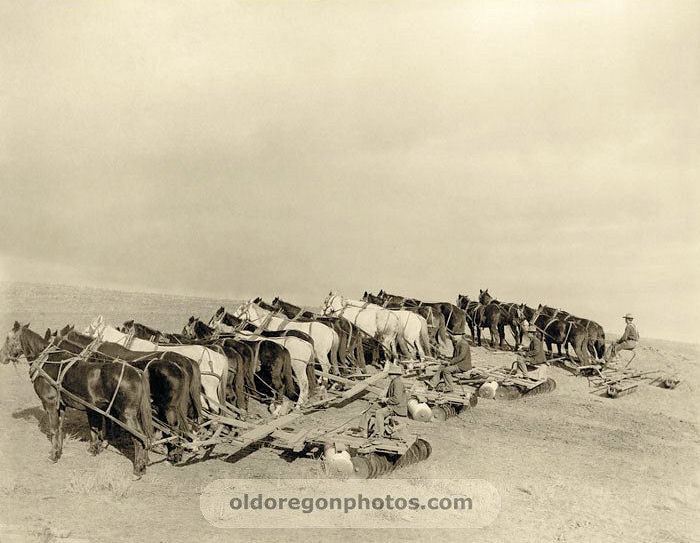
Wheat Farming the Peetz Farm - Central Oregon, 1900

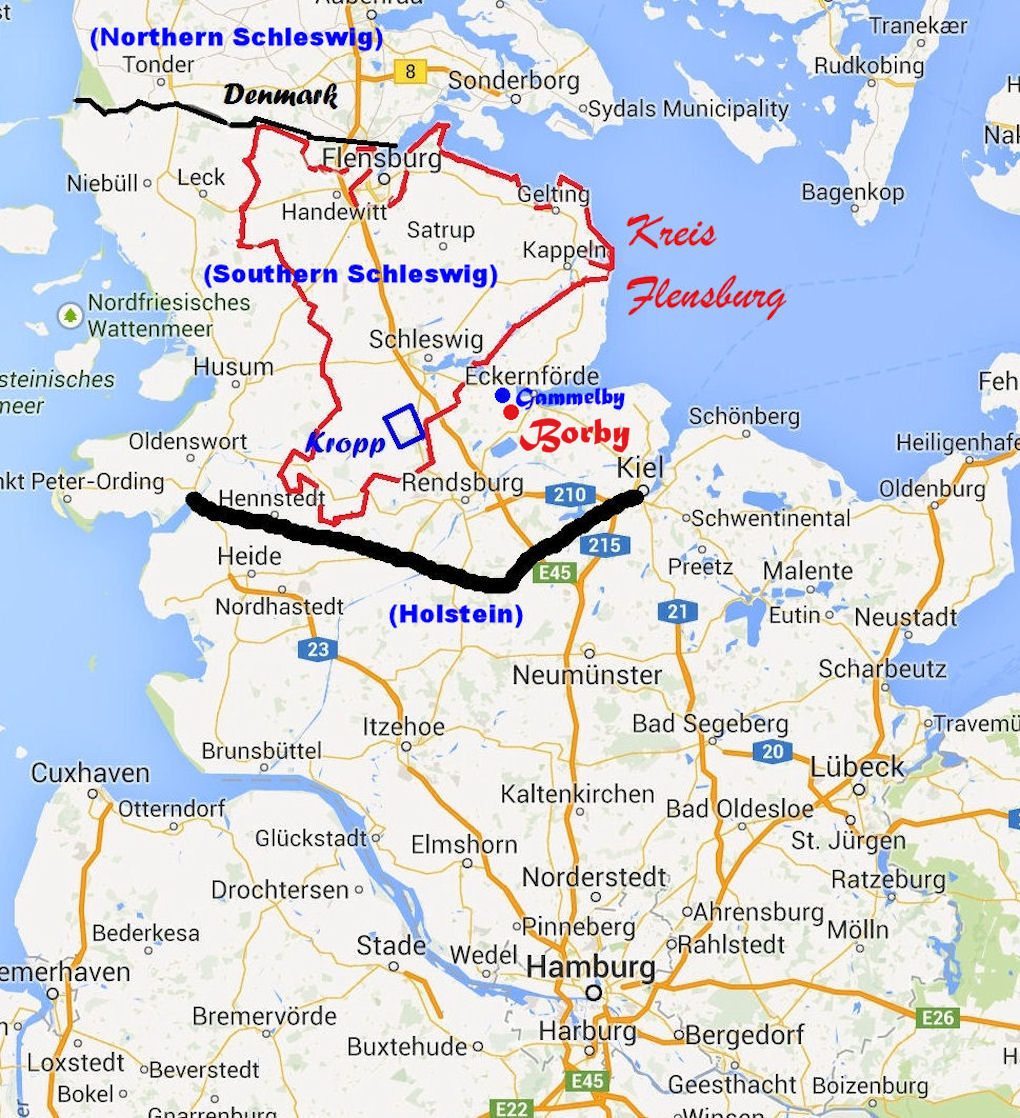
Kropp, Kreis, Schleswig-Flensburg, Prussia, Deutschland
Just south of the Denmark Border
Now known as Schleswig-Holstein
My Great-Grandfather Hans Peter Peetz
Was born August 1843 in Gammelby Village, Borby Parish, Schleswig, Germany (near: Kreis Schleswig Flensburg, Prussia, Deutschland). He was baptized at the age of 12 in a nearby river and died in March 1909 in Posen, Bremen Township, Cook County, Illinois. He married Margaretha Maria Amalie 'Anna' Peterson in late 1865 or early 1866 in Schleswig, Kreis Flensburg, Schleswig, Deutschland. She was the daughter of (Heinrich) Peterson and (Caroline Peterson). Anna was born in September 1842 in Kreis Flensburg, Schleswig, Prussia, and died in February 1879 in Bremen Village (Posen), Bremen Township, Cook County.
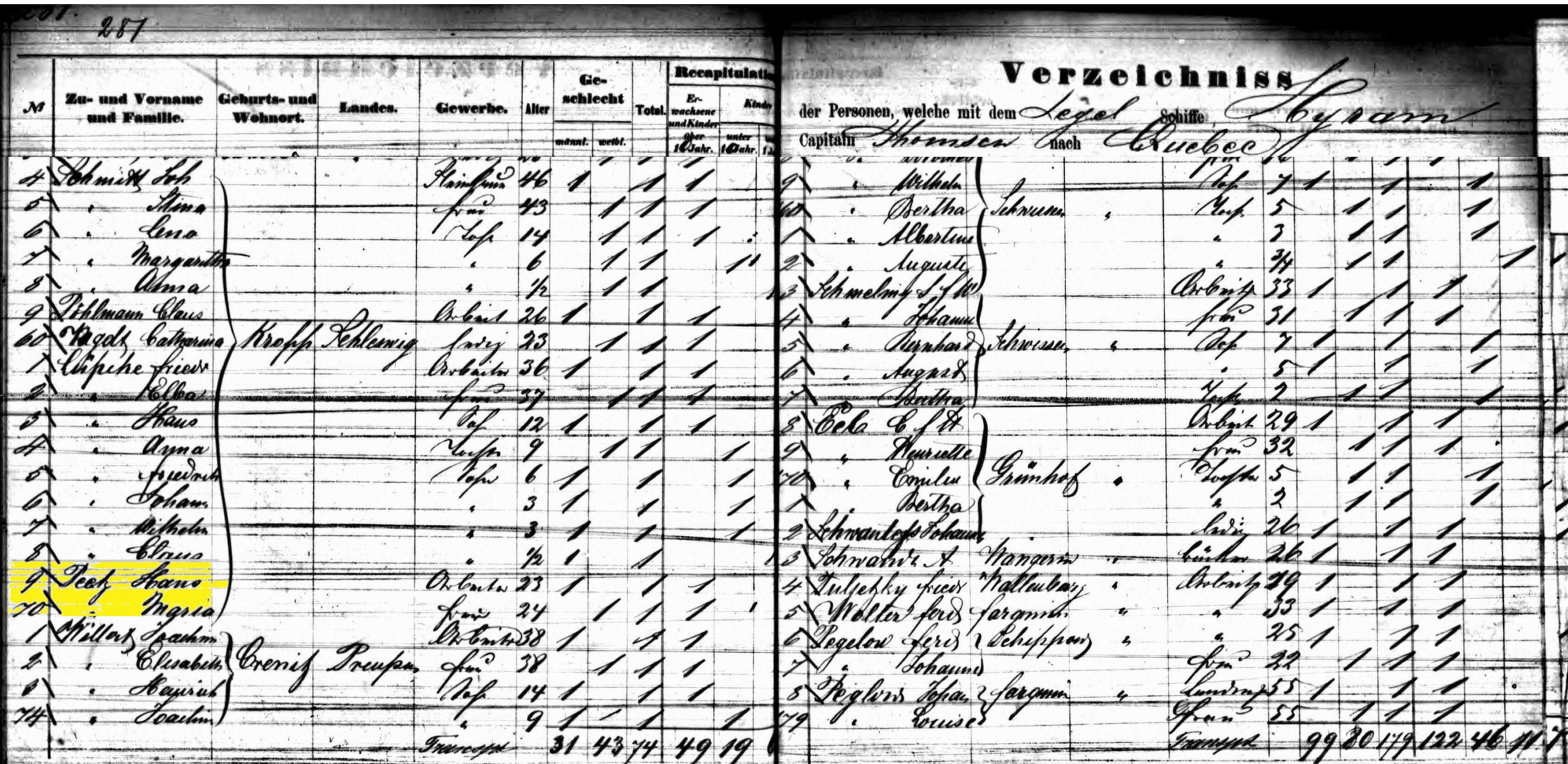
For emigration through ‘unterzeigneten’ are ‘engagirt’
(Passengers # 69 & 70 – Hans & Maria Peetz, a worker and his wife, age 23 & 24 from Kropp, Schleswig)
Hans and 'Anna' began their journey to America from their home in Kropp, Kreis Schleswig about April 16 ~ 19, 1866. Sailing aboard the “Hiram”, a three masted – square rigged Barque Sailing Ship from Hamburg to Quebec. Conditions during the 50 day crossing were not the best to say the least – 2 children were born on the journey, but 8 died and 2 were sick – all which concerned 6-month pregnant Anna. After arriving in Quebec on June 4, 1866 they made their way to Chicago.
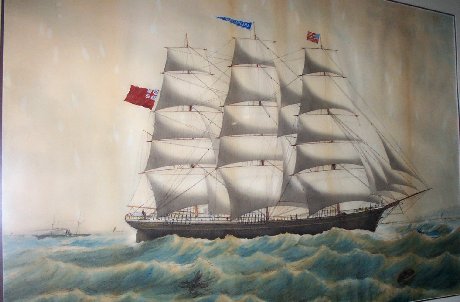
Barque Sailing Ship
Hans took a position in the Union Stock Yards which had opened in 1865 and they made their first home nearby around Lake and Wabash Streets in ‘Germantown’ not far from the stockyards. In 1866, over 52,000 German settlers called this area home.
Probably the most famous of Chicago's older industries were the stockyards. In early years there were a number of small stockyards located in various sections of the city. By 1865, the scattered stockyards were too small and inefficient to handle the increasing numbers of livestock being shipped to Chicago. The scattered stockyards were consolidated when a consortium of nine railroads joined with the packing yards to establish the Union Stock Yards. The yards were located just outside the city limits, from 39th to 47th and west of Halsted Street to Ashland Street. From their earliest years, the Union Stock Yards were the largest and busiest in the world and Chicago became the meat capital of the world.
Three children were born while Hans and Anna lived in Chicago; Caroline 'Lena' in 1866; Carl 'Charlie' was born in 1868; and Heinrich 'Henry' in 1870. There was a Cholera epidemic in 1869-1870, from which Hans almost died. After the birth of Henry in 1870, they moved out of Chicago to Bremen Township. The following year on October 8, 1871, the Great Chicago Fire began. They had moved from the area where the fire raged for two days and nights, covering over 2,100 acres, destroying 17,450 buildings and leaving 70,000 homeless out of a population of 324,000.
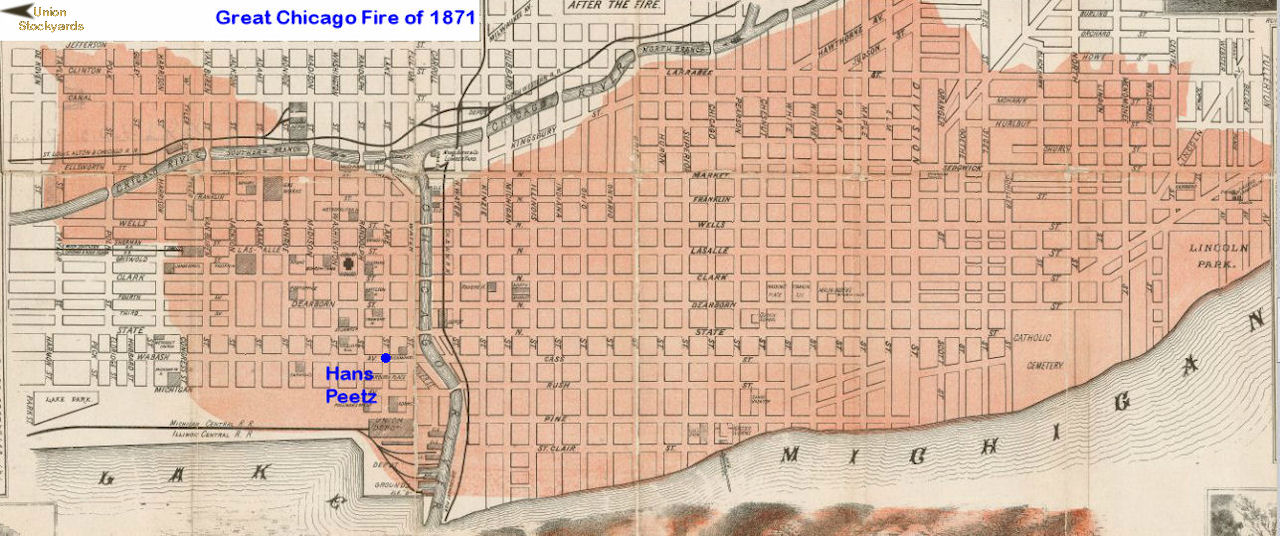
After their move to Bremen Village (now Posen), Hans purchased seven acres of land at 145th and Western Avenue and built a home. The house had four rooms down and three rooms upstairs.
Hans also built a saloon next to his house, named 'Peetz Place.' The saloon was a large one story building with a kitchen and bedrooms in the rear. Hans was popular with the citizens of Bremen Village because of the way he ran his business. When he first opened his saloon, men would cash their paychecks and spend the entire amount on drink. Their families suffered; so Hans built a parlor on the front of the building and worked out a way to help the families of his patrons. Thereafter he would cash the men's paychecks, give them enough to get drunk on, and then go to the parlor where the wives would receive the rest of the paycheck. Everyone was happier.
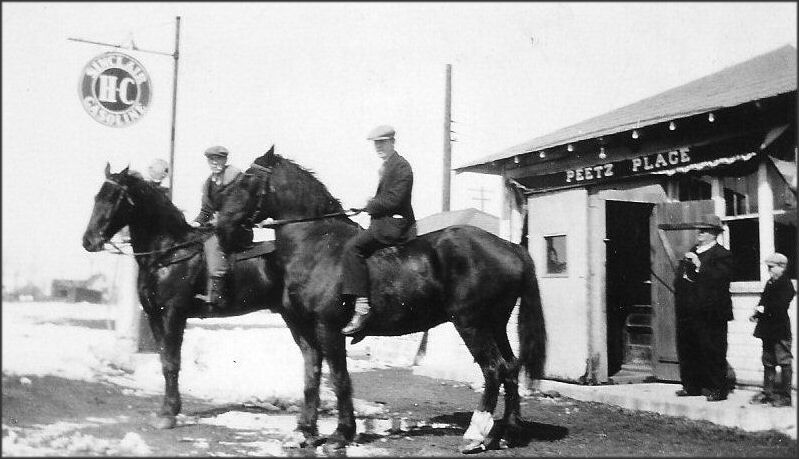
Peetz Place - 145th & Western - Posen, Illinois
Located along the Vincennes Trail, Hans' Place was located mid-way between the Sauk Trail and the Union Stockyards in Chicago. His three fenced acres allowed buyers from the local stockyards to select their purchases from farmers in the area. Often after six PM when the roads were less traveled herds of cattle and flocks of sheep were driven north to Chicago. Pigs were shipped in large box wagons and fowl taken by wagon in crates. The buyers would board at Hans’ place and the cattle drivers would 'lay over' to give the weary herders and their animals a period of rest before proceeding on.
Hans also raised chickens, ducks, geese, and pigs. He butchered meat for farmers, made sausage, cured and smoked meats. He made great wines and brandy; elderberry, dandelion, grape, blackberry and black currant which was used as medicine. Hans was known as a 'nice man’ that could cook, clean, hang the wash and sew.
In 1887, Bremen Village was a tiny piece of the vast farmland of this great prairie state began to be settled by immigrants who had traveled so long and so far in search of freedom and a better life for themselves and their families, and because of their hard work, their diligence, their love of the land, this lovely community flourished.
Hans was prosperous and affluent in Bremen Village. He became a charter member of the German Blue Island court of the Independent Order of Foresters (I. O. O.F.) when it was organized, 26 September 1882. He was an officer when the Odd Fellows reorganized into the Harmonize Lodge No. 2, Independent Order of Odd Fellows. He later became a landlord after the cattle drives ended with the completion of the railroads.
Many Polish immigrants were immigrating to America from Europe. They were hard-working, devoted, faith-filled assembly dedicated to improving their lives. Because of their strong Catholic faith, they petitioned the Archdioceses of Chicago to send a priest to look after their spiritual needs. In 1894, the St. Stanislaus Bishop and Martyr Catholic Church was established with a Polish pastoral overseer and in 1898 Father Serfino Cosimi came to serve the congregation.
Father Serfino guided and encouraged the people to incorporate the community and even prevailed upon a prosperous and affluent, Hans Peetz, not to have the village named after him but instead after the city in Poland from which the group had come, Poznan. The village of Bremen was incorporated in 1887 and in 1889 Hans became the president of the Village of Posen. After it was organized in 1901, he served as village president for many years preceding his death.

Hans was naturalized as a citizen of the United States before the District Court of Cook County, Chicago, on the 24th day of January 1874 at the age of 31.
Hans and Anna Peetz attended the 'Erste Deutsch Evangelisch Lutherische Kirche' (First Evangelical Lutheran Church in Blue Island). Three additional children were born after they moved to Bremen Village; Anna (1872), Wilhelmina (1875) and Otto (1876). Heinrich ‘Henry' was confirmed in 1871, was the first notation of the Peetz family, recorded in the Lutheran church records Annie and Otto were also confirmed at the church. They attended the church until 1879 when Hans wife Margaretha (Anna) died in February at the age of 37 from Heart Disease and Kidney Failure and complications of Bright’s disease.
On 13 March 1892, Hans left New York to journey to Hamburg to visit his sisters.
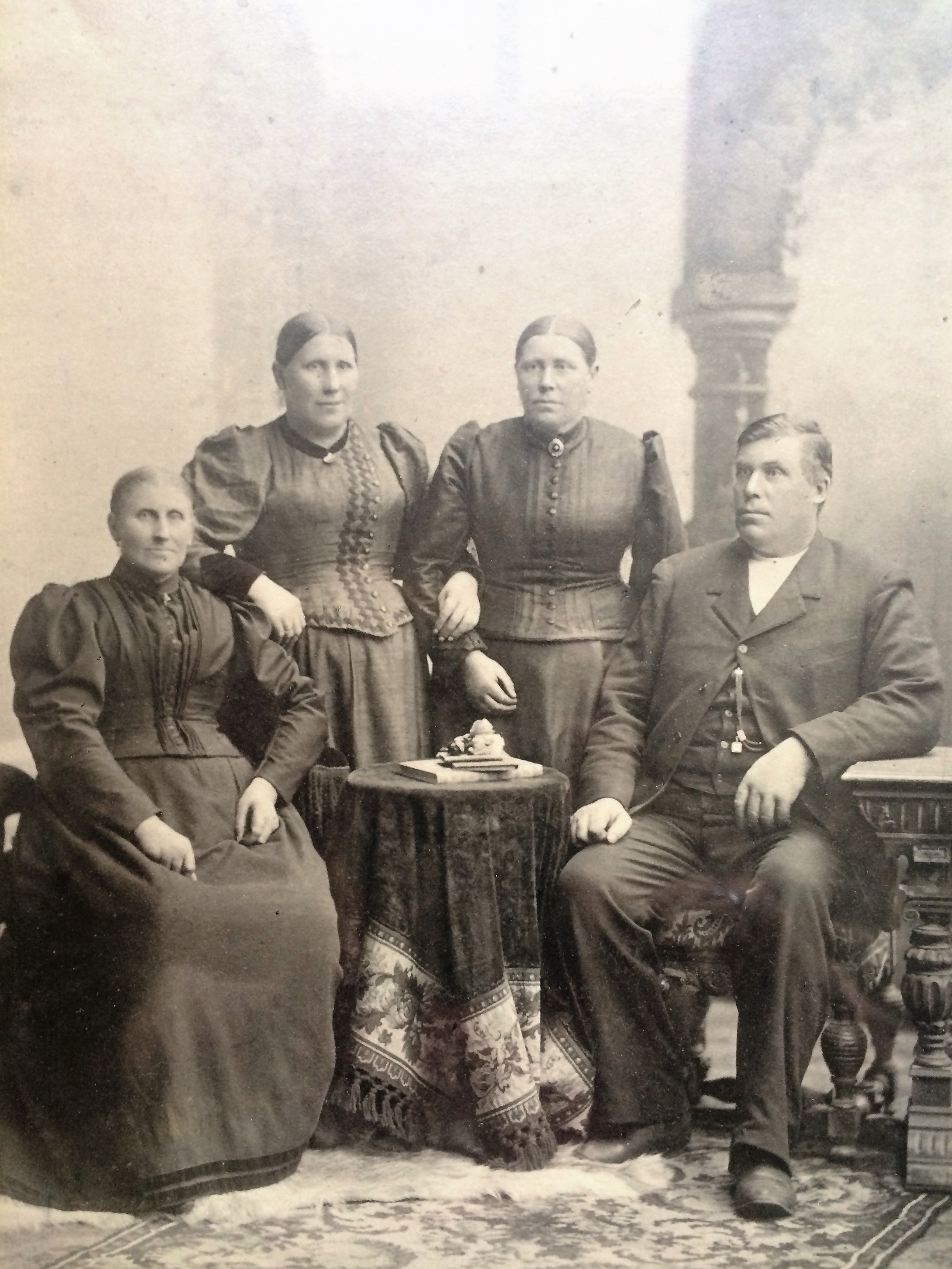
Hans' sisters (L to R) Magdalena - Charlotte - Magaretha - Schleswig Holstein, Germany circa 1894
Photo from Rick Reuss
Hans returned to America from Magdeburg in March 1893. He reapplied for a passport on October 15, 1894 and made a return visit to Germany aboard the ship 'Lahn' (New York to Bremerhaven). Hans returned from Germany on January 25, 1895. He went through the Castle Gardens Immigration Center in New York where they show a record of his arrival. These frequent visits may be related to the death of parents. The 1900 Federal Census shows that his parents were both born in Germany and had five children, out of which, five were still living. The Census also shows that in 1900, Hans (56) said that he was a farmer and was living with his son, Otto (24). In 1905, he went to Walla Walla, Washington to visit his brother, Carl. Considering the distances involved, the Peetz family stayed amazingly connected.
Hans voted religiously against prohibition. Most Germans strongly distrusted the moralistic crusaders and temperance reformers, who they called 'Puritans'. But in 1897 Hans found himself at the center of the controversy when he was issued a Liquor License.
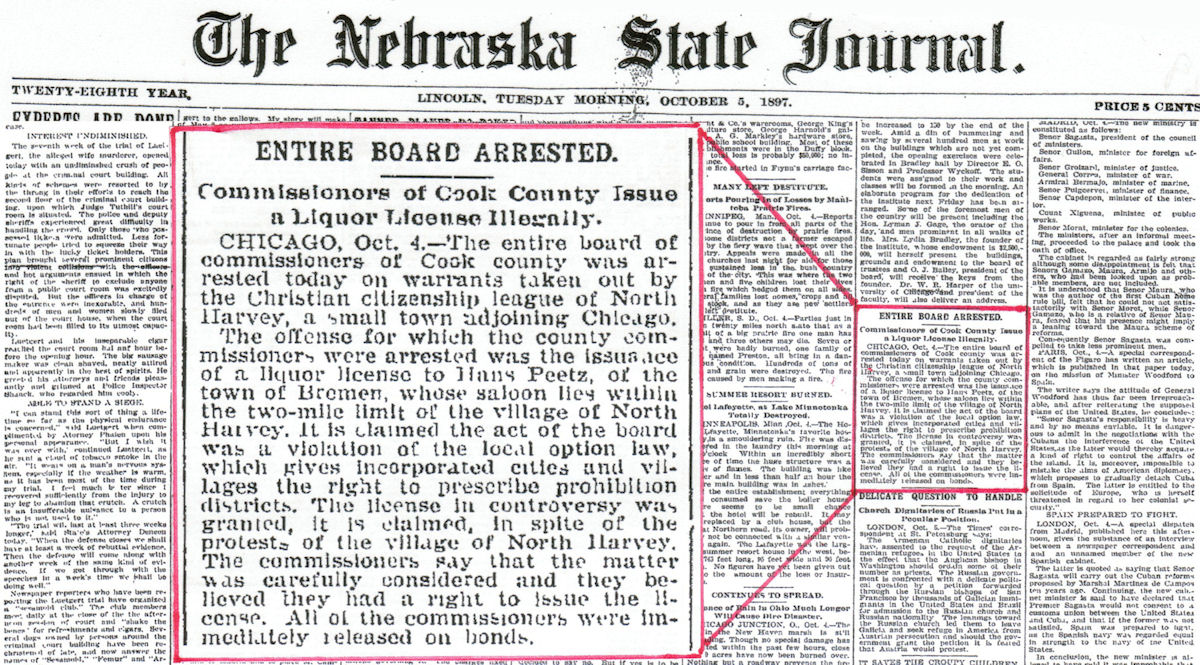
Hans Peter Peetz died of Intestinal Carcinoma in March 1909 at the age of 66, in Posen, Bremen Township. He was taken to Krueger Funeral Home in Blue Island. He was buried in Old Thornton Township Cemetery (LI IE). Anna is buried next to him in LI IE -B but she is undocumented in the Old Thornton Township Cemetery Register. The tombstones are now missing and all that is left on the lot is the bases of the two stones. Old Thornton Cemetery is one of three-clustered local cemeteries on Ridge Road in Thornton Township between the town of Thornton and the town of Homewood.
Notes for Margaretha Maria Amalie 'Anna' Peterson: Margaretha Maria Amalie 'Anna' Peterson was born in Schleswig. She immigrated to America in 1866 at the age of 23, with her husband, Hans Peetz and pregnant with their first child. Anna had a brother, George Peterson, who immigrated and settled near Ida Grove, Iowa.
Margaretha 'Anna' died in February 1879, her death certificate states that she had lived only 14 years after arriving in Illinois. She died in Bremen at the age of 37 years, 6 months and 3 days of Valvular Heart Disease which she had for 16 years and complications of Bright’s disease with kidney failure which she had for 11 months prior to her death. Her body was kept at home, lying in state for 25 days. She was then placed in a casket with a heart-shaped wreath of forget-me-nots and a lock of her auburn hair was given to each child. She was taken to the Frist Evangelical Lutheran Church of Blue Island for services. Because of the deep snow, the casket was taken to Thornton Township Cemetery on a bobsled directly over the fields. She was buried in the East Side, (LI ID) of the Thornton Township Cemetery. She was survived by her husband, Hans Peetz, and 5 children, Caroline 'Lena' (13 years old), Charles (11), Heinrich (9), Annie (7), and Otto (3). -Ruth Peetz
| ||•For More Information... | |
| ||• Blue Island Illinois | ||• Posen Illinois |
| ||• Sauk Trail | ||• Old Sauk Trail |
| ||• Hubbard / Vincennes Trail | ||• Vincennes Trail |

Caroline 'Lena' Magdalene Peetz was born August 1866 in Chicago, Cook County, Illinois, and died July 1958 in Milwaukee, Wisconsin. She married Henry August Reuss on November 1887 in Bremen Township, Cook County, son of Joachim Reuss and Anna Clausen. He was born August 1865 in South Lawn (Harvey), Thornton Township, and died May 1965 in Milwaukee, Wisconsin. When Caroline 'Lena' was young, she was nicknamed Lena because of the number of Caroline’s in the family - Uncle Thies' wife, cousin Caroline, Henry Heide's daughter, and Mrs. Jenson. Lena left school when her mother died in 1879 to take care of the house. When she was 18 years old, she became a maid for Dr. Jesse Kauffman. 'In 1918, the Spanish Influenza was widespread throughout the country and claimed many lives among soldiers and citizens alike. One of the most prominent of Blue Island citizens was Dr. Jess R. Kauffman, 233 York Street, who contracted the flu while tirelessly attending to the numerous calls made upon him. He labored night and day administering to flu victims, and refused aid for himself until finally forced to bed, but too late to save his life. He died 30 October 1918. Dr. Kauffman was born in Blue Island 18 December 1883 and was associated with his father, Dr. J.S. Kauffman.' Among other victims in Blue Island was Marie 'Mary' Schmidt, daughter of her sister, Anna, also died October 1918.
Lena married Henry August Reuss on November 1887 at the age of 21. They first lived two doors south of 117th and Church Street, near our Sacred Heart Catholic Church on Vincennes Avenue. There Hedwig 'Hattie' Katerine was born in July 1888. Henry worked at the Blue Island Brick Yard at 123nd and The Grand Trunk railway tracks. It was a long walk from 117th so they moved to the Dockendorf home on Maple and Birdsall in Blue Island. Amanda Katherine Josephine was born there.
Henry and Lena then purchased property on Mozart Street on the west side of Blue Island. Henry got bricks from work and with the help of friends, built the foundation and a full basement. A sister-in-law's brother was a carpenter and erected the house. They bought the doors and windows at Shaffer’s Drug Store on Western and Grove and moved into the house on 1 March 1891. The walls were lathed and ready for plaster, but they couldn't afford the plaster. Henry Johann Reuss was born 10 days later on March 1891. This property still stands at 12710 Mozart. The corner house consisted of a kitchen and four rooms. Additions were made, second floor, back porch, and other additions when Otto and Anna Reuss lived there.
Henry and Lena broke away from the Lutheran Church along with many others. They helped to establish St. Paul Evangelical Church, organized 11 June 1892, under the name of Evangelical Friedens Gemeinde. Reverend A. Niedergesass took charge of the mission. That same year, 1893, Henry was out of work and the family had to move back to Hans Peetz' house to make it through the winter.
Henry farmed 20 acres of land at Vermont and Crawford. They owned a few cows, and as their children grew older, they began to sell milk to the neighbors. This began their dairy business 1900-1912. Henry bought a horse, a wagon, and a harness for $6.00 and later bought a second-hand milk wagon. He returned to farming 1912-1915 after leaving the dairy business. In 1915, he began to work for the City Street Department and worked there for 28 years until his retirement in 1943. They moved to Blue Island and resided at 12957 South Highland. Before her death in 1958, Henry and Lena moved to Milwaukee, Wisconsin where Caroline 'Lena' Peetz Reuss died, July 1958. Caroline and Henry were married over 70 years. Services were held at Krueger Funeral Home in Blue Island, with interment at Cedar Park Cemetery in Calumet Park, Illinois. -Ruth Peetz contributor of the Peetz research of Richard Reuss, 1978
Lena and Henry were interred at Cedar Park Cemetery in the Rose Garden, NE1/4, Lot 1, Block 1, Lots 1-4. All grave-markers are flat stones. The markers are now over-grown with grass and it is impossible to determine actual placement of their markers.
Notes for Henry August Reuss:
Telsha Reuss and Henry Holm Henrichs were natives of Flensburg, about 20 miles north of Stadt (city) Schleswig, Schleswig, Deutschland where Hans and Marie Peetz were born. In 1855, they immigrated to Illinois and eventually settled on 30 acres just north-west of 151st and Western. In 1870, he quit the farm and bought a grocery store at 13409 Western, which had been established some years before by Reimer Boe. The Reuss brothers, grocers on the west side are grandsons of this pioneer.
Jochiam Reuss was born March 1828 in Flensburg, Germany. He married Anna K. Clausen in Flensburg. After reading letters from his sister, Jochiam, decided to emigrate to America with his wife and six months old child, Theis. They arrived in New York in January 1857, after seven weeks at sea. They moved to Illinois and settled on 40 acres on Western Avenue next to Henry Henrich's. Jochiam raised corn, potatoes and hay, besides chickens, ducks, geese, and a few pigs. He was a farmer all of his life. Anna died February 1898, Jochiam died May 1900. They are both buried in First Evangelical Lutheran Cemetery in Alsip.
Their first child, Theis Reuss, was born June 1856, in Flensburg. Theis owned a saloon and boarding house at 66th and Halsted, Chicago. More children were blessed to this union: John Reuss; Claus Reuss married Carolina Willig; Henry August Reuss married Carolina Peetz; Catherina Reuss, married Frank Rohwedder and moved to Texas; Maria Reuss, married Otto Easier and moved to Minnesota.
-Taken from John Volp’s “The First 100 Years – 1835-1935, a Historical Review Of Blue Island, Illinois”
Children of Caroline Peetz and Henry Reuss are:
Hedwig 'Hattie' Katherine Reuss, born July 1888 in Blue Island, Illinois. She married Frederick Labahn November 1909 in Evangelical Friedens Gemeinde (St. Paul) of Blue Island. Hedwig was born two doors south of 117th and Church Street, near Our Sacred Heart Catholic Church on Vincennes Street. She was christened August 1888 at the First Evangelical Lutheran Church of Blue Island by Rev. J.H Doerman. -church records.
They had seven children: Lorrane Henry - born June 7, 1910 (died September 10, 1910); Marvin Frederick - 1912; Stanley Carl - 1913; Frederick Carl - 1914; Mildred Caroline - 1916; Loretta Elsie - 1918; Irving William - 1920; and Arnold in 1921.
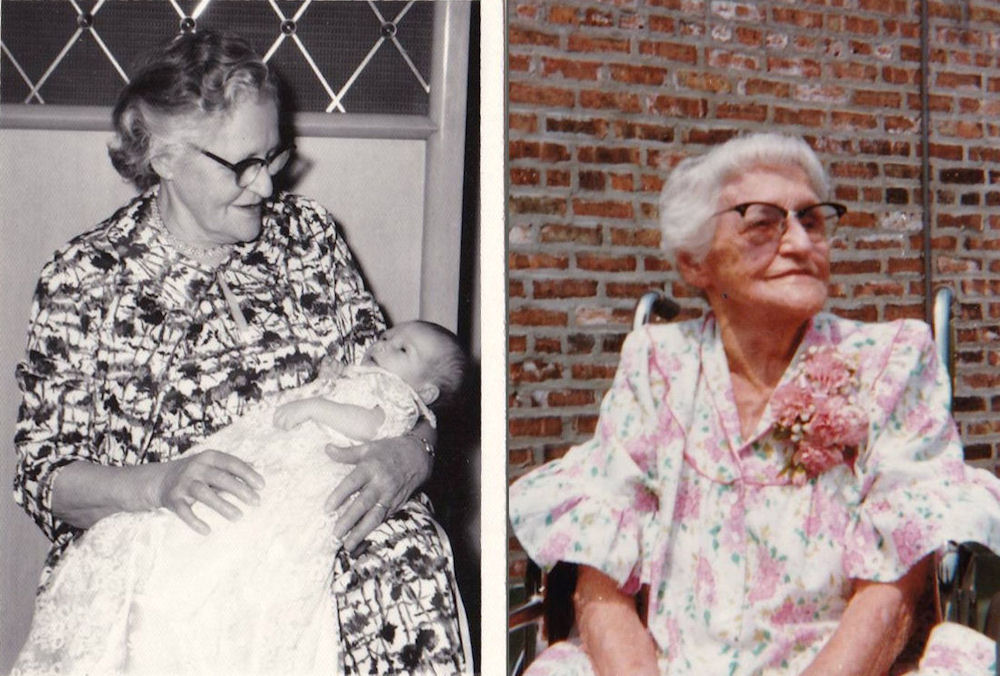
||• Hedwig 'Hattie' Katherine Labahn (Reuss) - daughter of Caroline Peetz and Henry Reuss •||
In the Black & White photo she is holding one of her grandchildren. The color photo was taken in July 1983. She passed away at the age of 99 in 1987.
Almanda Carroline Josephine Reuss was born September 1889 in Blue Island, Worth Township, and died 1981 in Blue Island, Worth Township. She married Carl 'Charles' E. Roegner November 1909 at her parents home in Blue Island. They were attended by Caroline Reuss, Heinrich Reuss, Friedrick Labahn, L. Roegner and Hattie Reuss. Ceremony performed by Rev. M.P.H. Doerman -church records
"C.E. Roegner - Funeral services were held at the First Lutheran church for Carl E. Roegner, 57, of 12710 Mozart St., a life-long resident of the community. Rev. Wm. Feme officiated the service and burial will be at the Lutheran Cemetery. He is survived by his wife, Mrs Almanda (nee Reuss) Roegner; four daughters, Elizabeth Snyder, Dorothy Edwards, Margaret Schultz, and Helen Carstens; one son, Kenneth Roegner." -The Blue Island Sun-Standard, 1943 ~ Burial in First Evangelical Lutheran Cemetery of Alsip, Section 3 4-11 & 12
Children of Almanda Reuss and Carl Roegner are:
Dorothea Henriette Roegner was born July 1912 in Blue Island. She was christened August 1912 in the First Evangelical Lutheran Church of Blue Island. Her godparents were Heinrich Reuss and Auguste Roegner. Christening performed by M.P.F. Doerman. -church records. She married Edwards.
Elizabeth Roegner. She married Snyder.
Margaret M. Roegner was born on March 1915 in Blue Island, Worth Township, Illinois. She married Fred G. Schultz who was born on September 1911. Margaret and her husband, Fred are buried in First Evangelical Lutheran Cemetery in Alsip, Section 3 27-9 A&B
Helen Roegner, born 1917 in Blue Island, Worth Township; died 2005 in Blue Island, Worth Township. She married Robert J. Carstens; born 1910; died 1971 in Blue Island, Worth Township. Helen and her husband, Robert are buried in First Evangelical Lutheran Cemetery in Alsip, Section #3 28-7 A&B
Henrich Johann Reuss, born March 1891 in Blue Island, Illinois and was christened July 1891 in the First Evangelical Lutheran Church of Blue Island. His godparents were L. Reuss and Johann Reuss. Christening by Rev. J.H Doerman -church records. He married Wilhelmine 'Mamie' Fischer September 1917 in Blue Island. He married Eleanor Klein October 1941
Alfred Henry Reuss, born January 1893 in Blue Island, Worth Township. Arthur Otto Martin Jochen Reuss, born December 1895 in Blue Island, Worth Township.
Arthur Otto Martin Jochen Reuss was born December 1895 in Blue Island, Worth Township. He married Anna Polansky October 1914 in Blue Island, Worth Township. She was born in Bohemia, Czech Republic. Arthur was a railroad office clerk, 1920-1930. -Cook County Census
Children of Arthur Reuss and Anna Polansky are:
Lucile Reuss, born 1921 & Magdalene Reuss, born 1922.
Maria Christina Martina Reuss, born February 1899 in Blue Island, Worth Township; died in Minnesota. She married Otto Easier.
George Louis Reuss, born February 1907 in Blue Island, Worth Township. He married Jean Polansky February 1928.

Carl Charles 'Charlie' Peetz, born August 1868 in Chicago, Cook County; died December 1941 in Blue Island, Cook County. He married Juliana Nitz in August 1894 in the First Evangelical Lutheran Church in Blue Island; she was born May 1869 in West Prussia and died on January 1939 in Blue Island, Cook County. Charles was a fireman in Posen when his father, Hans Peetz, was the village president (mayor) of Posen. He was a member of the I. O. O.F. He worked with his brother, Otto, in the family beer distribution and saloon businesses. He first lived on ‘Grandma’ Fischer's property (mother of Henry Johann Reuss's first wife). Charlie drank a lot until he bought the Henry Young house at 2262 Broadway. John Krich had the mortgage and told Charles "the first time you miss a payment, I'm going to foreclose." Charlie never touched another drop of liquor. Julie Nitz Peetz kept a spotless house and did washing and ironing for spending money. They did not have children. In 1920, they lived in Calumet with a boarder, George Young. Charlie died in December 1941, one month before his brother, Otto. He was taken to Mt. Hope Cemetery for cremation; his ashes were given to Otto Peetz for scattering.
-Ruth Peetz contributor of the Peetz research of Richard Reuss, 1978
"Mrs. Charles Peetz (nee Juliana Nitz), died at her home at 2262 Broadway, after a long illness. She was born May 1869 in West Prussia and came to this country at the age of 12. She was married to Charles Peetz, August 1894. She is survived by her husband. Funeral services held January 1939, from the funeral home at 2001 Vermont St. with cremation at Mt. Hope Cemetery. Rev. Emil Helm conducted the services." -Sun-Standard, Blue Island, 1939

Heinrich 'Henry' Peetz, was born in April 1870 in Chicago, Cook County, Illinois. He married Mamie Loomis in 1905 in Bremen Village, Cook County, Illinois. Mamie was born in July 1882 in Poland. After the death of Hans in 1909, Henry operated the saloon at 14637 Western Avenue, near Posen, Illinois. It was connected to the beer distributing company located at the same address which had been owned by his father, Hans, and co-managed with his brother, Otto. Henry is listed in 'Index to Blue Island, An Illustrated Review of its Leading Industries, Churches, Schools, Societies, Officials, Business Men and Citizens, 1915' by E. Palma Beaudette. On the 1920 Census, Henry and Otto listed their occupations as 'soft drink parlor' Operators which had become the accepted name of the old saloon keepers.
Henry became a trustee of the Village of Posen. Henry and Mamie resided at 14637 Western in Posen but they did not have children. Eventually he purchased a tavern at 13310 Olde Western Street in Blue Island, Illinois. Henry died in November 1931 in Posen, Bremen Township, Illinois and Mamie died in April 1948 in Dolton, Illinois. Henry and Mamie are buried in Washington Memory Garden Cemetery very close to Henry's sister, Anna Charlotte Peetz. Henry and Mamie are interred in the Melrose garden, lot 11.
-Ruth Peetz from the research by Richard Reuss, 1978

"The 1920's became gangsters and Prohibition. The society of the 1920's was at odds with itself. The older generations and the middle class still clung to the Puritan ethics that accompanied our Founding Fathers and wallowed in propriety. Religious groups made up mostly of women searched to assert themselves political and formed a crusade against immoral practices including the consumption of liquor. The Women's Christian Temperance Union and the Anti-Saloon League were founded in the early 1800's in response to the growing lawlessness in and around saloons. Later, in response to the excessive immorality shown by saloon keepers in the Mid-West in which is now know as the Bible Belt, their long moral crusade known as the temperance movement gained it's first victory. They pushed their agendas as state after state passed prohibition laws. In 1919, the 18th Amendment to the Constitution was ratified and it became illegal to distribute and manufacture distilled spirits in the United States.
There was a backlash response to the religious fervor that forced it rural values on the rest of the nation. This backlash was in part caused by the economic upswing dazzling most of the nation. Unemployment was low, wages were up and many people of all classes found themselves with money to burn. Following the example of the wealthiest society, the middle-class was buying on credit and speculating in the stock market which was rising at a feverish pace. This created a new class of wealthy among the higher social circles known as the New Rich. They resented the hold of the temperance movements with their Victorian ideals and began their rebellion with a zeal matching that of the Prohibitionists.
This became the Golden Age of the mob, which prior to Prohibition was limited to rackets, extortion, prostitution, and infiltration of labor unions. Prohibition provided a demand that was lucrative and provided the bank roll for the mob to become an invisible force in our modern economics today. Smaller bootleggers and distributors were 'squeezed' out in this lawless age of the Tommy gun. Gang wars caused by territorial disputes spilled out onto urban streets and the nation began to quietly think that the 'prohibition experiment' was failing. The Capone gang was big in Chicago. They smuggled from Canada liquor for private distribution as well as for consumption in underground bars called speakeasies. Speakeasies came in a number of disguises like funeral homes with a secret entrance……where everyone drank 100 proof 'coffee.' These disguises were known as fronts and often had big gorillas as doormen waiting behind a sliding panel to hear the password.
Gangsters were popularized during the era. It was at this time, they were viewed by most as folk heroes. The money derived from bootlegging and racketeering trickled into the American economy and the majority prospered because of it. Chicago, as it was situated close to Canada, was a major point of liquor distribution into the United States. It affected everyone as the cash poured into the city and it saw a major growth spurt and made the 1920's the decadent age.
-"Chicago, the Roaring 20s"
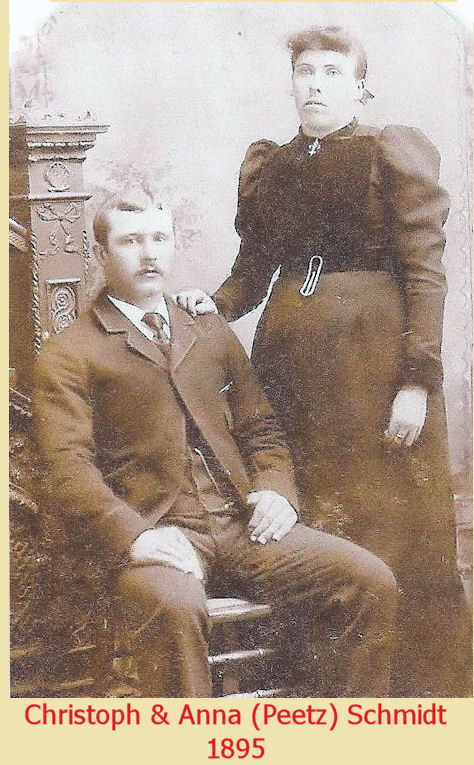 Anna ‘Annie’ Charlotte Friedrike Peetz,
Anna ‘Annie’ Charlotte Friedrike Peetz,
born October 1872 in Bremen, Bremen Township and died December 1930 in (Mercy Hospital, Cadillac) Orange Township, Kalkaska County, Michigan. She married Christoph 'Christ' Andrew Schmidt in December 1890. He was born July 1870 in Bremen, Bremen Township, and died November 1943 in (Lockwood Hospital, Petoskey) Orange Township, Kalkaska County, Michigan.
Anna was born at 14637 Western Avenue in Bremen Village. She was confirmed at the First Evangelical Lutheran Church in Blue Island. Her father, Hans Peetz purchased seven acres of land at 145th and Western Avenue, at 14637, he built a home and a tavern. He was a prosperous and affluent man in Bremen Village. As part of the tavern, he had a boarding house for the cattle- drivers and their stock on their way to Chicago Stock Yards.
Anna attended the First Evangelical Lutheran Church in Blue Island, along with her parents. Her brother, Heinrich was confirmed in 1871, was the first notation of the Peetz family, recorded in the church records. Annie Charlotte and her brother, Jakob Otto were later confirmed. They attended the church until her mother, Margaretha's death in 1879, no further entries in the church records for her family after her death were found.
Annie was only seven years old when her mother died. Her father never remarried, she was brought up by her single father with some help from two neighbors, Kate Tietje and Ann Miller. They taught her how to cook, keep house, and become a lady.
Anna married Christoph Andrew Schmidt at the First Evangelical Lutheran Church of Blue Island, December 1890 by J. H. Doermann, pastor of the church. The wedding procession started at her home and they sang all the way to the church. They bought a home at 3108 Wood Street, South Lawn (now Harvey), in Thornton Township. Here, they had eight children.
Christoph and Annie had 8 children while residing in South Lawn. When her father, Hans Peetz, died in 1909, he left her a sizable inheritance. Family members say that Christoph was careless with the money, spending a lot of it in bars. In 1914, Annie and Christoph bought a farm in South Boardman in northern Michigan. The inheritance money made this possible. Annie died in 1930, in South Boardman, at the age of 58 of pancreatic cancer.
"Mrs Anna Schmidt, 58 years old and a resident of Orange Township for the past 16 years passed away at midnight Tuesday at Mercy Hospital in Cadillac, after a lingering illness. Mrs. Schmidt, the wife of Chris Schmidt, was born in Cook County. She was the mother of nine children, seven of who survive. She moved to S. Boardman 16 years ago. The funeral services will be at the William Schultz home to the First Evangelical Lutheran Church, the Rev. M.P.P. Doermann will officiate." Sun-Standard, Blue Island
Anna was transported by train to Homewood, Thornton Township, Illinois and is buried in Washington Memory Gardens, Original Plot, Lot 14, 1NE1/4, space 3.
Christoph 'Christ' Adnrew Schmidt was born in Cooper's Grove in 1870, one year before the Chicago fire so I was unable to obtain a birth certificate, all Cook County records burned in the Chicago fire. Christoph was baptized July 1870 in the First German Lutheran Church of Blue Island. His godfather was Andreas Schmidt. Andreas Schmidt was listed on the 1870 Federal Census as a farmhand from Prussia on the farm belonging to Christoph Heinrich Schmidt. He is thought to be a nephew of Christoph who immigrated to Cooper's Grove and worked on Christoph's farm until he could buy a farm of his own which he later purchased in Iowa previous to 1880. While on the Christoph Heinrich Schmidt farm, he married Freiderike Sufs, January 1872, in the First German Lutheran church in Blue Island. Theresa Schmidt geb Kott and Elisabeth Kott geb Stoehr, attended the couple.
Christ moved to Bremen (now Posen) by the time he was 21 and was living there when he applied for his marriage license with 18 year old, Annie Peetz from Bremen. Possibly he worked in her father, Han Peetz' Saloon or his beer distributing Company at 14637 Western Avenue in Bremen.
The Lutheran pastor, J.H Doermann, performed the ceremony at the First Evangelical Lutheran Church in Blue Island in December 1890. They were attended by Christopher's sister, Elizabeth 'Lizzie' Schmidt and her husband, August Willig. After their marriage, they settled in Harvey.
In 1891, Harvey was incorporated from the village of South Lawn, a land
Grant from the state to the Illinois Central Railroad in the 1850s. The Harvey Land Association envisioned Harvey as a model town, a blend of capitalism and Christianity. It promoted the suburb as a temperance community but by 1895, the residents voted by a slight majority to license saloons, ending the temperance experiment. They offered steady work for skilled labors and induced a handful of manufactures to establish factories in town and divided the residential and the industrial sections on either side of the railroad. The investors provided residents with a high quality of city services and encouraged home ownership by offering potential residents a variety of house plans. It also offered a place with lawns and fresh air, away from the crowded conditions of the city.
By 1892, Harvey had 10 industrial plants, 850 residents, 73 miles of street and 5 railroads with 70 passenger trains daily. The steam-powered passenger trains of the Illinois Central Railroad delivered riders from downtown Chicago to Harvey in only 30 minutes. There was also an electric street railway tying the community to Chicago. Passenger trains on the Illinois Central (IC), the Big Four, the Grand Trunk and the Chicago terminal railroads offered transportation to a wide variety of destinations. When the Chicago and Southern Traction Company ran its first electric train, called the 'dinky' from Chicago Heights to Harvey in 1906, it was reported in the Star, 'it caused much interest in the citizens and was a welcome sight for the people because it provided relief from the inefficient transportation facilities. Hundreds of workers would use this accessible transportation daily to Chicago where they found work in the factories and mills. Other uses for the interurban lines prompted colorful nicknames for the cars, such as 'milkshake,' because farmers often used the lines to transport milk to the market. The 'crazy car' sent patients from Cook County Hospital in Chicago to Kankakee. Window on the trolley, which ran only at night, were barred and it was reported local residents could hear the wailing of patients as they made their way to the Kankakee asylum. Interurbans were also rented for funeral processions, as many of the local cemeteries were along the lines.
When World War I started in 1914, German Americans were sometimes accused of being too sympathetic to the German Empire. Teddy Roosevelt denounced 'hyphenated Americanism' and insisted that dual loyalties were impossible in wartime. Several thousand vocal opponents of the war were imprisoned. Thousands were forced to buy war bonds to show their loyalty. The Red Cross barred individuals with German last names from joining in fear of sabotage. One man was hanged in Illinois, apparently for no other reason than that he was of German descent. The killers were found not guilty of the crime and the hanging was called an act of patriotism by a jury. A Minnesota minister was tarred and feathered when he was overheard praying in German with a dying woman. Some Germans during this time 'Americanized' their names (e.g. Schmidt to Smith) and limited their use of the German language in public places. Newspapers also printed blacklists of Germans, including their addresses, headlined as German Enemy Aliens.
German Americans adopted mainstream American customs and switched their language to English. Older German members were attending German- language services. In German parochial schools, the children spoke English among themselves, though some of their classes were in German. After the US entry into WWI, nearly all German language ended on the side of the British, as did most German-language church services. German was spoken in the Christoph Andrew and Anna Schmidt home. His son, my father, was the first generation to speak English in the home. My father spoke German fluently but only swore in German.
Germans were intensely loyal to their fatherland. Before the United States entered the war, German Americans had been one of America's favored immigrant groups, but after, many met with fierce hostility and quietly preserved their cultural traditions. After Germans were placed in concentration camps, Christoph and Annie choose to buy a farm in South Boardman in northern Michigan. Annie's father, Hans Peetz had died in 1909 and left her a sizable inheritance. The inheritance money made the move possible. Before they left Blue Island, Christ and Annie had their children baptized, May 1914, at "the other church on Vermont" -MB. It was possibly St. Pauls or Evangelical Friedens Gemeinde church where Annie's family attended after leaving the First Church of Blue Island.
Christoph and Annie had nine children, eight of which survived to adulthood. Annie died in 1930 at the age of 58 of pancreatic cancer. Christ remained on the farm and periodically, the children would live with him. Andrew, his son, and Lucille lived with them until Andrew purchased a farm in Lodi. Chris, his son, and Florence lived with him when Christ was killed in an automobile accident a quarter mile from his farm. Christ was never the same after the accident, he grieved for him the rest of his life.
Christ lived in Mancelona after he sold the farm. He would go to the Antrim County Store and have his purchases put 'on my bill.' Later Chris and William would pay 'his bill' as agreed with the management, 'he was to get anything that he wanted and they would see that his bill was paid.' He loved catsup and would drink a bottle of catsup as others might drink a soda. In 1941, two years before his death in 1943, Christ moved to Kalkaska.
"Christoph Andrew Schmidt, 73, died November 1943 at Lockwood hospital in Petosky from Cellulities (streptococcus) with Septicemia or the right arm after a cut on his hand from a rusty saw, two weeks after injury to his hand. Mr. Schmidt had not been in very good health for number of years but was able to be up and around almost to the last.
"Mr. Schmidt was the son of Mr. and Mrs. Christoph Schmidt of Blue Island. He was united in marriage to Anna Peetz who preceded him in death. To this union nine children were born - three preceded him in death. Surviving are four daughters; Minnie Schultz of Blue Island, Ann Calvin of Mancelona, Lydia Six and Theresa Stuck of Mishawaka, and two sons; Andrew Schmidt of South Boardman, and William Schmidt of Wayne.
"Funeral services were held at the Berg Funeral Home and the body was then shipped to Blue Island for burial with services there. Services were held in the funeral home at 2601 Vermont Street in Blue Island. He was buried in Hazelcrest Cemetery in Homewood, Illinois, November 1943." -Obituary, Blue Island Sun-Standard and the Antrim County News, November 1943
Christoph was transported to Homewood, Thornton Township, by train accompanied by his son, Andrew Schmidt. Christoph was buried along side his wife, Annie Schmidt, in unmarked graves in Hazelcrest Cemetery (now Washington Memory Gardens) - original, block 14, lot 1, NE 1/4 space 4, in Homewood, Illinois. It is a wonderful cemetery, with music playing about the grounds when visitors are there. I was never able to find the graves as there is no identifiable marking.
Children of Anna Peetz and Christoph Schmidt are:
Wilhelmine Heneriette Theresa Schmidt, born July 1892 in Harvey, Cook County; died April 1978 in Blue Island, Cook County.
Marie 'Mary' Schmidt, born October 1894 in Harvey, Cook County; died October 1918 in Harvey, Cook County.
Anna Schmidt, born November 1896 in Harvey, Thornton Township; died July 1956 in Mancelona, Antrim County.
Andrew Schmidt, born February 1900 in Harvey, Thornton Township, Illinois; died November 1986 in Battle Creek, Michigan.
Lydia Magdalina Schmidt, born May 1902 in Harvey, Thornton Township; died November 1978 in Coeur d' Alene, Idaho.
Christoph 'Chris' Henry Schmidt, born January 1905 in Harvey, Cook County; died November 1937 in South Boardman, Orange Township.
Allen Schmidt, born March 1907 in Harvey, Thornton Township; died 1908 in Harvey, Thornton Township.
Wilhelm 'Bill' William Schmidt, born June 1909 in West Harvey, Cook County, Illinois; died July 1960 in Kalkaska Hospital, Kalkaska, Michigan.
Theresa 'Tracy' Susanna Schmidt, born November 1911 in West Harvey, Thornton Township, Illinois; died July 1993 in Mishawaka, St. Joseph County, Indiana.
Otto Jochiam Anton Peter Peetz (my Grandfather), was born March 1876 in Bremen, Bremen Township, and died January 1942 in Harvey, Thornton Township. The 1900 Federal Census shows Otto then 24, was living with his father Hans and working on his father's seven acre farm at 14637 Western in Bremen Township. Hans was also operating a saloon and beer distribution company there. Otto worked as a clerk on the railroad, as a motorman for the streetcars in Chicago and as a brakeman for the railroad, losing some toes in an accident.

He married Augusta 'Bertha' Manske in July 1901 at the Community Evangelical Church in Harvey, Illinois. She was born April 1876 in Germany, and died May 1953 in Harvey, Thornton Township. Augusta immigrated to America in 1885 and became a naturalized citizen in 1892.
In 1910, the Census shows Otto (34) was living with his wife, Augusta (33), children; Alma (8), Arthur (6), Mabel (4), and Robert (2). Otto Peetz is listed on the 'Index to Blue Island, An Illustrated Review of its Leading Industries, Churches, Schools, Societies, Officials Business Men and Citizens, 1915' by E. Palma Beaudette.
See also:History of Posen

Chicago's reputation as the 'wickedest city in the West' survived all attempts to clean it up and the city contained far more saloons than churches. By 1919, it appeared that the Dry’s had finally achieved their goal. In that year the United States Congress and three-quarters of the states ratified the Eighteenth Amendment. “Dry’s” had wanted to close saloons since the day the first one opened, and temperance laws had been passed as early as the 1850's.
Wartime hysteria made the passage of Prohibition possible. Anti-German feeling ran high throughout the country and many breweries were owned by Germans. It was far easier for Americans to give up liquor for patriotic reasons than for moral reasons. Hungry soldiers, it was argued, needed grain far more than distillers did. Thus, the denial of drink became another way to win the war. A 'noble experiment' had begun which would determine whether or not banning liquor would improve the quality of life in the United States by eliminating saloons, reducing crime and public drunkenness and saving families. That many people were not interested in the experiment was evident from the results of a prohibition amendment offered to Chicagoans in a 1919 referendum: 147,000 people voted for the amendment while 406,000 voted against it.
Because of the extremely weak enforcement provisions written into the law and the question of who actually was to enforce the law - federal or local officials - speak-easys flourished in the city and most drinkers had little trouble finding a bootlegger. Chicago's Mayor 'Big Bill' Thompson gave bootleggers little reason to fear they would run into any trouble with local law enforcement officials because the issued licenses for thousands of 'soft drink parlors' which usually served quite a bit more than soft drinks. Reform Republicans, led by State Attorney Robert Crowe, blamed the mayor for the wave of violence and deaths that swept the city. But vice and corruption had flourished in Chicago long before prohibition, the new law simply made profits from illegal activities much higher and competition that much more fierce. Over two hundred gangsters met violent deaths in the first few years of prohibition and, between 1920 and 1930, 550 gangsters were shot to death. No one was arrested for these murders, and in the eyes of many citizens, an alliance existed between the gangsters and the forces of the law. Al Capone himself estimated that it cost him 30,000,000 a year in payoffs to do business in the city. Another reformer, Charles Mariam, political scientist at the University of Chicago, described the working of the 'Big Fix' in his book on Chicago Politics are the result of a coalition of corrupt politicians, bankers, real estate developers, tax assessors, and gangsters who had joined forces to control an apathetic and confused populace. The fixers robbed the city blind while voters argued about beer.
Another example of the 'Big Fix' was the widening of city streets. Big Bill Thompson appointed several of his friends as 'condemnation experts.' The experts were to receive no salaries but would merely take a gratuity of l% of the value of the property they condemned, the real estate experts received over $2,000,000 in gratuities for services. The Tribune sued the city for overpayment and ordered the 'experts' to return over $1,700,000 to the city treasury. Another city scandal involved more of the mayor's closest friends in a scheme that cost the school system over $3,000,000 for shoddy or undelivered school supplies. The city filed for bankruptcy late in 1930.
Despite all the scandals and corruption and gangland killings, Big Bill Thompson remained highly popular with the voters. To many he was the champion of the little guy and the enemy of big business, the utility trusts, and the millionaires. Thompson used the prohibition issue as the chief vehicle for maintaining his power, but he also favored a nickel bus fare and a program to exempt all incomes under 5,000 from federal taxation. He exploited the war and opposition to membership in the League of Nations to retain voters support. Everyone expected Big Bill to run for a third term in 1923 but he was a counter of votes and knew that the charges of corruption gave him little changes with the voters.
The Democratic Party ran Judge William Dever, a member of a small reform faction of the party. 'Dever and Decency' became the slogan of the reform coalition that backed the judge. Devers won the election. After eight years of Thompson, Chicago was ready for reform. He placed a 24 hour guard in all breweries where beer had been sold openly for $50 a barrel during the Thompson years. Over six thousand 'soft drink parlors 'were in operation, and Dever closed 1,400 his first year in office. Because of mounting criticism of his actions, Dever announced that personally he was not a prohibitionist but that as a mayor he had to enforce the Constitution. He assured the voters that as soon as enough complaints had been received by Congress, repeal would begin.
One problem in Dever's campaign against crime was the lack of cooperation from the police. Over 60% of the Chicago Police Force was known to be taking bribes from bootleggers and there was nothing he could do about it. Al Capone had moved his headquarters to Cicero in 1934, but most of his stills remained in Chicago. Dever felt the laws were unenforceable, and he hoped to be relieved of their burden before prohibition destroyed the city. Crime and vise forced 75% the middle-class to the suburbs.
"In 1928, Thompson was reelected but events beyond his control changed the face of Chicago politics. Wall Street crashed in October 1929 and countless thousands of people across the country were out of work. Chicago was especially hard hit, and the Thompson administration found itself totally unprepared to meet the massive problems of unemployment and relief. The politics of ethnicity and Americanism offered much to people in an era of affluence; poverty and despair required other solutions to public problems and other symbols of security." -taken from "History of Chicago - Module 3 Chapter 1 Chicago in the Roaring Twenties" Roosevelt University, Chicago, 2009
In 1930, Otto then 54, was still the "proprietor of a general store". He was living with his wife, Augusta (53), and children; Alma (28), a sales lady at the General Store of her father, Arthur (26) chauffeur at the General Store, Mable (24) bank teller, Robert (22) chauffeur of a fire truck, Raymond (19), Ethel (15) and Harry (11).
"Otto J. Peetz, 64, 14637 Western, a lifelong resident of south Cook County, and prominent in community affairs, died suddenly of heart trouble at Ingalls Memorial Hospital in Harvey. Mr. Peetz and other members of the family had great anxiety this winter over the safety of their son, Harry, a sailor at Pearl Harbor, Hawaii during the Jap raid of December 7. However, they later heard from the young man that he was safe and sound."
-Blue Island Sun-Standard, January 1943
"Mr. Peetz is survived by his wife, Augusta Peetz, who emigrated from Germany with her family in 1885, at 9 years of age. His brother, Charles preceded him in death a month earlier, in December 1941, while a sister Mrs. Lena Reuss survives." "Mr. Peetz was born in Harvey, March 1877. He served for many years as a trustee of the village of Posen, and for seven years was president of school district 143. He was in the beer distributing business at 14637 Western. Mr. Peetz was only recently installed for the third term as president of the German- American Club which organization he led in a path of true American patriotism. They only recently purchased $300 defense bonds."
"Mr. Peetz, like his recently deceased brother, was a member of the I.O.O.F. lodge and they participated in his funeral services which were held at Halinan’s Funeral Home at 2601 Vermont. Rev. Emit Helm, pastor of the Evangelical Community Church officiated. Burial was at Mt. Greenwood."
-Blue Island Sun-Standard, January 1942
Burial papers read as follows: Otto Peetz, husband and Augusta Peetz L. O., of 14637 South Western Avenue at Halinan’s in Blue Island, died on a Sunday in January at 11:45 am at the age of 64 years. He died of Heart Block Myocarditis, John W. Blair, M.D. Interred at Mount Greenwood, Lot 6, Section 12, Tier 15, Grave 3W, 1-21-42.
Children of Otto Peetz and Augusta Manske are:
Alma Bertha Peetz, born August 1901 in Posen, Bremen Township; died 1977. She married Johannes Siebons. Alma was christened, October 1901, at the First Evangelical Lutheran Church of Blue Island. Godparents were Bertha Manske, Line Ruess and Anton Heintz. Christening performed by Rev. H.K.G. Doerman. -church records
Arthur Heinrich Ernst Peetz, born July 1903 in Posen, Bremen Township. Art was christened, October 1903, at the First Evangelical Lutheran Church of Blue Island. Godparents were Heinrich Peetz, Ernst Manske and Christine Reimer. Christening performed by Rev. H.K.G. Doerman. -church records
Mabel Louise Peetz, born May 1905 in Posen, Bremen Township. Mabel was christened September 1905 in the First Evangelical Lutheran Church of Blue Island. Her godparents were Bertha Heintz and Louise Manske. Christening performed by Rev. H.K.G. Doerman. Mabel married Orville Fay, they resided in Cheyenne, Wyoming when she passed away in October 1979.
Robert Augusta Hans Peetz (my Father) was born July 1907 in Posen, Bremen Township, Illinois. He was christened in December 1907 at the First Evangelical Lutheran Church of Blue Island. His godparents were Auguste Manske and Tina Reimer. Christening performed by M.P.F. Doerman. He married Ruth Lucille Dahl who was born in December 1916 in Blue Island, Cook County, Illinois. Robert worked as a driver for the Peetz Family business in Posen. Later in life he was a heavy equipment operator for the State of Illinois. 'Dad' was a Justice of the Peace & a Precinct Captain in Calumet Township, Cook County, Illinos for 17 years prior to his death in January 1961. After his death, 'Mom' worked as a clerk in a store and as a factory worker. She was also a Calumet Township Auditor and retired after working for many years in the Blue Island City Clerk's Office. She died in May 2011 after suffering a stroke at the age of 95.
The Dahl Family - Under Construction
Children of Robert and Ruth Peetz are: Ruthellen Peetz was born February 1948. She married Stanley Konkol (born: February 1938) in August 1974. They had two daughters, Debra Ellen was born April 1973 and Denise Elizabeth was born September 1977. Stanley passed away in July 2009 and Ruth Ellen passed away in May 2010.
Robert Peetz was born in September 1949. I was raised on the Southside of Blue Island living in the house Charles and Julia Peetz bought on Broadway. I went to Lincoln School, watched the Calumet Sag Canal get widened, spent summers at the Memorial Park Pool and graduated from D.D. Eisenhower High School. I spent three years plus in the Navy, got discharged and returned to Vietnam as a civilian working for the U.S. Army. I married Ngo Thi Mai (born December 1948) in October 1971 in Can Tho, Republic of Vietnam. We have a son, John who was born in Vietnam in December 1971. We returned to Blue Island in 1974 and I worked at Allis-Chalmers building diesel engines and at Pullman Standard building New York subway and Amtrak Superliner passenger rail cars. In 1981 we moved to Oklahoma City and I began a 27 year career working for the U.S. Air Force Reserves. We all currently reside in Washington State, Bob and Mai in “Admiral’s Cove” on the Sunny Side of Whidbey Island and John lives a short ferry ride away in Everett, Washington.
Raymond Edward Carl Peetz, born October 1910 in Posen, Bremen Township. Ray was christened in February 1911, in the First Evangelical Lutheran Church of Blue Island. Godparents were Edward Reinier and Carl Peetz. Christening performed by Rev. M.P.F. Doerman. -church records
Ray married Alice Boyens (born August 1915) in November 1941. They had two daughters, Patricia in 1942 and Roberta in July 1943. Until construction of I-57 forced them to move to Blue Island in 1968, they resided in one of the houses built in Posen where the tavern Hans Peetz built in the 1870's was located on Western Avenue. Ray died in October 1977 and Alice in May 2012.
Ethel Henrietta Peetz, born April 1914 - 1998 in Posen, Bremen Township. After her first marriage to James O'Malley ended, she married John Pennavaria (born March 1929) around 1953. They lived in Hazel Crest, Illinois, until Ethel passed away in January 1998 and John in April 2003.
Harry Peetz, born December 1918 in Posen, Bremen Township, Illinois. "Cpl. Harry Peetz of the US Marine Corps who recently arrived in California from overseas, arrived home at midnight and surprised his folks. He will be home until December 16. He had four malaria attacks but looks and feels well nevertheless. He was present when Pearl Harbor was attacked, 7 December 1941, and he has been serving in the Pacific area ever since. An error was made last week, calling him Sergeant. Sorry we have to demote you to your real title this week Corporal Peetz, but welcome home!" -Blue Island Sun-Standard, 1944
In May 1952, Harry married Stephanie Stempin who was born in August 1917, they lived in Calumet Park, Illinois and had a daughter Theresa. Harry passed away in April 1988 and Steph passed away in July 1992.

Thanks to Dick Reuss, BJ Schmidt and Carol Caraccia for sharing their research and writing of the Peetz/Schmidt/Reuss family history.
